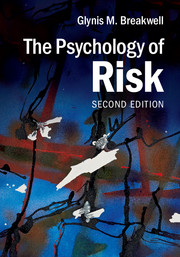Book contents
- Frontmatter
- Dedication
- Contents
- List of figures
- List of boxes
- Preface to the second edition
- Acknowledgements
- 1 A social psychological framework for analysing risk
- 2 Hazard perception
- 3 Individual and group differences in risk perception
- 4 Decision-making about risks
- 5 Risk and emotion
- 6 Risk communication
- 7 Errors and accidents; emergencies and disasters
- 8 Risk management; risk in complex systems
- 9 Social amplification, social representations and identity processes
- 10 Changing risk reactions: lessons from the psychology of risk
- References
- Index
7 - Errors and accidents; emergencies and disasters
Published online by Cambridge University Press: 05 October 2014
- Frontmatter
- Dedication
- Contents
- List of figures
- List of boxes
- Preface to the second edition
- Acknowledgements
- 1 A social psychological framework for analysing risk
- 2 Hazard perception
- 3 Individual and group differences in risk perception
- 4 Decision-making about risks
- 5 Risk and emotion
- 6 Risk communication
- 7 Errors and accidents; emergencies and disasters
- 8 Risk management; risk in complex systems
- 9 Social amplification, social representations and identity processes
- 10 Changing risk reactions: lessons from the psychology of risk
- References
- Index
Summary
Chapter preview
This chapter examines how human errors can produce hazards. It summarises the variety of types of error that come into play. One typology of errors focuses upon their aetiology and this is considered. The more general factors that result in human error are also outlined. It is emphasised that individual error must be seen in the broader context – determined by organisational structures and intergroup relations. The Chernobyl nuclear reactor accident is used as an illustration of the many error factors that can be at work in producing a major accident. It points to the significance of violations rather than error in the genesis of accidents, and this is explored. The chapter goes on to explain how errors not only create hazards; they can also be the product of hazards. Examples of hazard perception, risk-taking and error incidence are provided from everyday activities, like driving an automobile. The theory of ‘risk homeostasis’ is outlined and it is suggested that there is little empirical support for it. Similarly, the notions of error proneness and motivated errors are discussed but their limitations as explanatory tools are highlighted. The disaster at the Fukushima nuclear power station is described. The significance of major accidents and disasters, like Chernobyl and Fukushima, for the subsequent perception of hazards and risk decisions is presented. It is concluded that, while major accidents can have an impact on risk estimates and tolerance, their effect is time-limited. The similarities in the factors at play in the genesis of Chernobyl and Fukushima are explored. The definition of an emergency is examined. The possibility of emergency and disaster profiling, akin to hazard characterisation, is suggested. The significance of the anticipation of emergencies and planning for them in generating risk tolerance in emergency services is considered. Some of the common psychological consequences of emergencies and disasters are outlined and some of the factors that influence the efficacy of emergency warnings or trigger disaster preparedness are presented.
- Type
- Chapter
- Information
- The Psychology of Risk , pp. 190 - 216Publisher: Cambridge University PressPrint publication year: 2014



